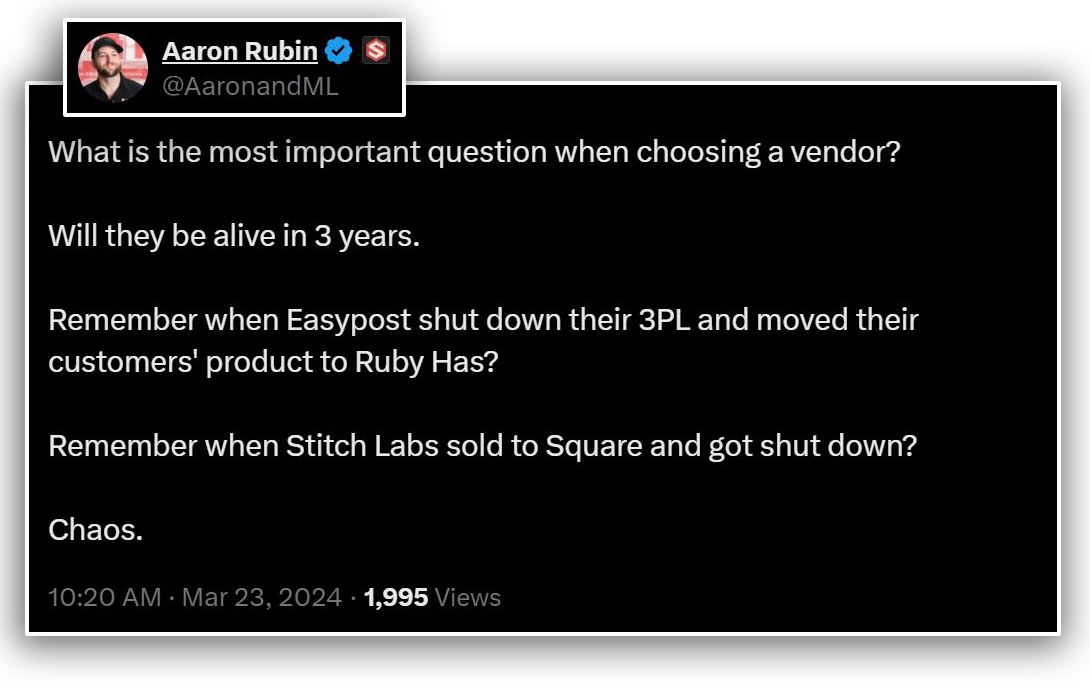
What are “growth ingredients”?
01
Before you get caught up in trying to chase the next growth levers and marketing tactics for your business, make sure your foundation is strong. This is what Matt Bertuli of Lomi & Peela Case describes as Growth Ingredients. Not only will these make your growth tactics more effective, they’ll help you build a more resilient business:
01
Price point
02
Margin profile
03
Built-in virality
04
Innovation level
05
Customer profile(s)
06
Natural repeatability
07
Type of sale (simple vs. complex)
08
Winds of change (tail winds vs. head winds)
P.S. do not feel discouraged if you don’t have all of these growth ingredients (no one does)
Go Deeper: follow Matt on X. 2) Listen to Matt and Jason Panzer of Hexclad talk about product differentiation & moat on the Operators podcast, episode 47, minutes 29 – 33. Apple Podcasts, YouTube
Is Seller Fulfilled Prime worth it?
02
That coveted Prime Badge can be yours without FBA … but only IF you can meet the requirements of Seller Fulfilled Prime. Logistics industry veteran Chad Carleton breaks down why that’s easier said than done. Two of the big requirements?
01
97% on-time delivery
02
Offer 1-day shipping to at least 30% of people in the U.S. who view your page and 2-day shipping to at least 74% (these percentages are lower for oversized items)
So, is SFP worth it? Here’s Chad: “Maybe … This is all just freaking hard. Most of the time the juice isn’t worth the squeeze. … the exceptions? 1) you have a strong sku with the ability to distribute inventory to at least 2, but probably 3 metro locations. 2) your product is in demand but oversized (according to Amazon), and FBA fees are too high. 3) your product is hazardous. 4) you live on the edge and want to lose sleep”
Things that are overrated in ecomm
03
In growing your business, it’s often more important to decide what not to do. Here are 3 ideas, c/o Dave Rekuc, President and COO of Bambu Earth, a D2C skincare brand.

Custom-developed HTML emails are never worth it, don’t do it

DTC businesses are not tech companies. Use off-the-shelf tech

Turning your website into an app has zero or negative marginal value
An overlooked step in selecting the right vendors for your business
04
Everyone is trying to sell you something. There’s a foundational question you should ask before you start looking at bells and whistles, and Aaron Rubin says this better than I can:

Go Deeper: Follow Aaron on X.
The promise (and perils) of Negative CAC
05
Creators like Mr. Beast and Logan Paul are now selling candy and energy drinks. And they benefit from something that’s been coined negative CAC—the ability to make money from the content that also converts customers.
This leaves many ecomm brands thinking, “can I do that too?” The answer is a strong maybe. And, even if you can, it’s not a golden goose you should expect to lay all your eggs.
Here’s Kevin Espiritu, founder of Epic Gardening, “The problem is, this model is a fantastic booster pack, but it needs to be the 1st/best acquisition channel, not the ONLY. If you over-rely on it, you’ll burn out the audience, and the only reason it even WORKS is that the media you make is for its own sake.”
Kevin goes on to point out that great content doesn’t mean you can just make an ask of your audience in each piece: “I think of it as depositing vs. withdrawing from a bank account. You won’t find me withdrawing often, but if I do, it’ll be for something I REALLY want (AKA a big product launch).”
And so, “I think a big mistake content-powered commerce companies make is not firing up aggressively enough on paid acquisition – it’s one we’ve made historically. If I was smarter I would have done this far sooner.”
Go Deeper: Kevin’s X post on negative CAC 2) For brands that aren’t content-native, check out Sean Frank discussing why Ridge chose to make uber-creator MKBHD an equity partner in their business as opposed to trying to build a content operation in-house. YouTube, Apple Podcasts
Thanks for reading, and see you in 2 weeks.
-Paul





